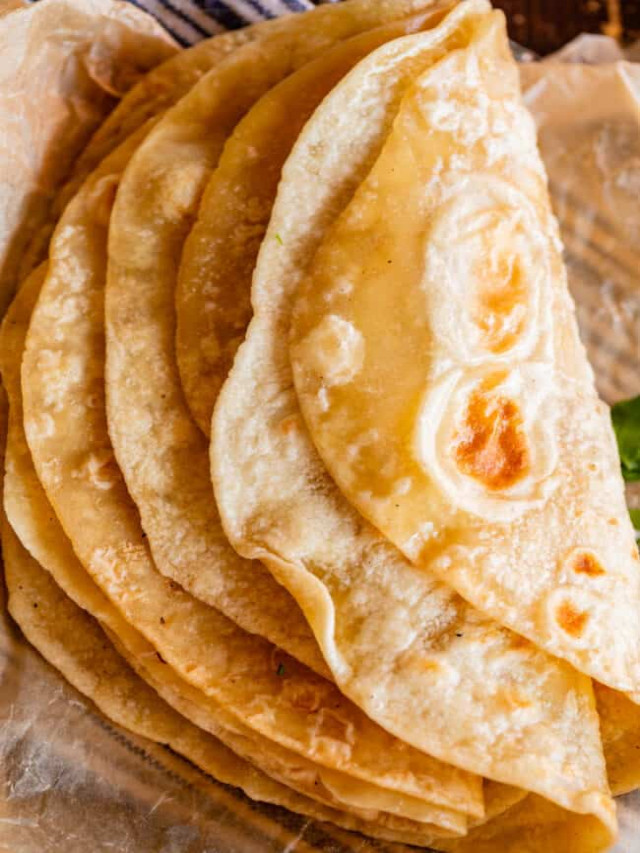Roti Recipe (Buttery Indian Flatbread) – The Food Charlatan



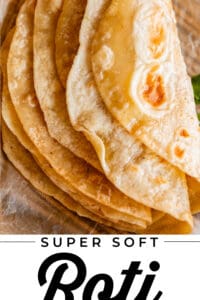
I can’t get enough of this Roti recipe! Roti is a super easy and delicious Indian flatbread. It is amazing when served with curry, totally perfect for sopping up extra sauce! I have all the tips you need to make sure this Indian bread turns out super soft. I will show you just how to make roti, step by step! Originally posted March 28, 2012.
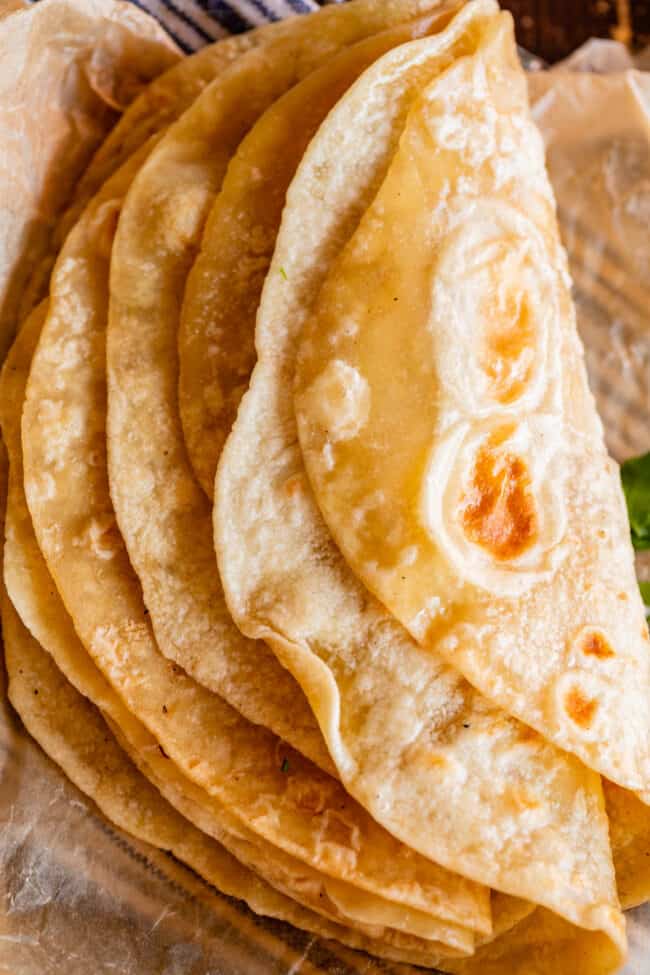
I was over at my parents house the other day and checked the fridge, obviously. I don’t think I will ever grow out of this habit. Mom’s fridge has Mom’s Food in it, and there’s just something nostalgic about your mother feeding you, even if you are in your 30s and have kids of your own. And even if all Mom has in there are some unrecognizable leftovers, I’m still going to check them out. Just to make sure, you know.
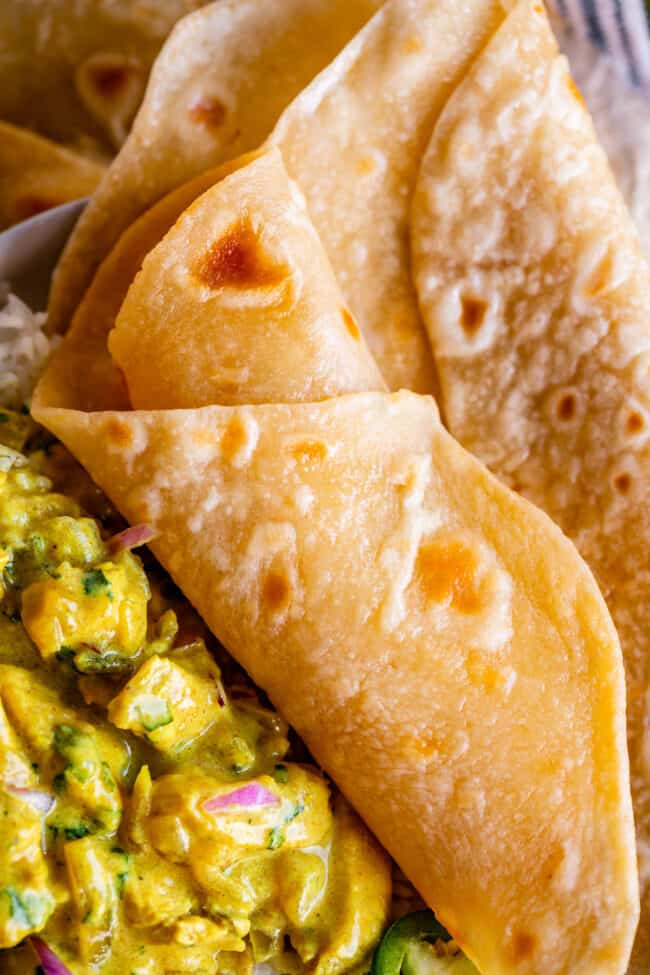
But last week I was over there and opened up the fridge to find a Little Caesar’s gift card on the shelf, propped up front and center. I asked my dad, what the heck is there a gift card in your fridge for??
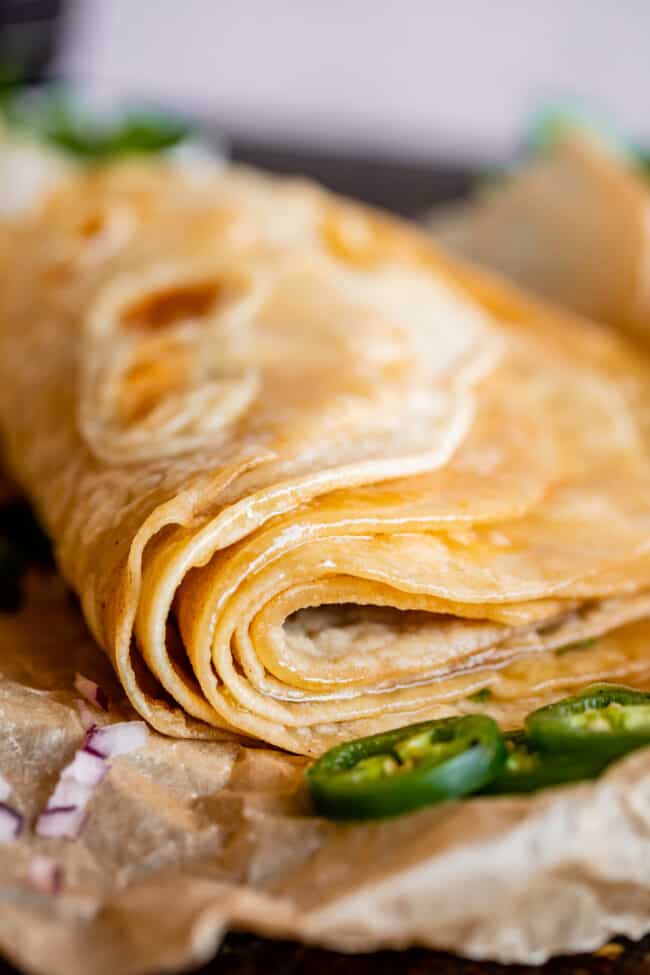
He said, “oh, yeah, someone gave it to us and we keep forgetting to use it. So we put it in the fridge to help us remember. Next time we’re hungry, we will open the fridge and remember, hey, pizza!”
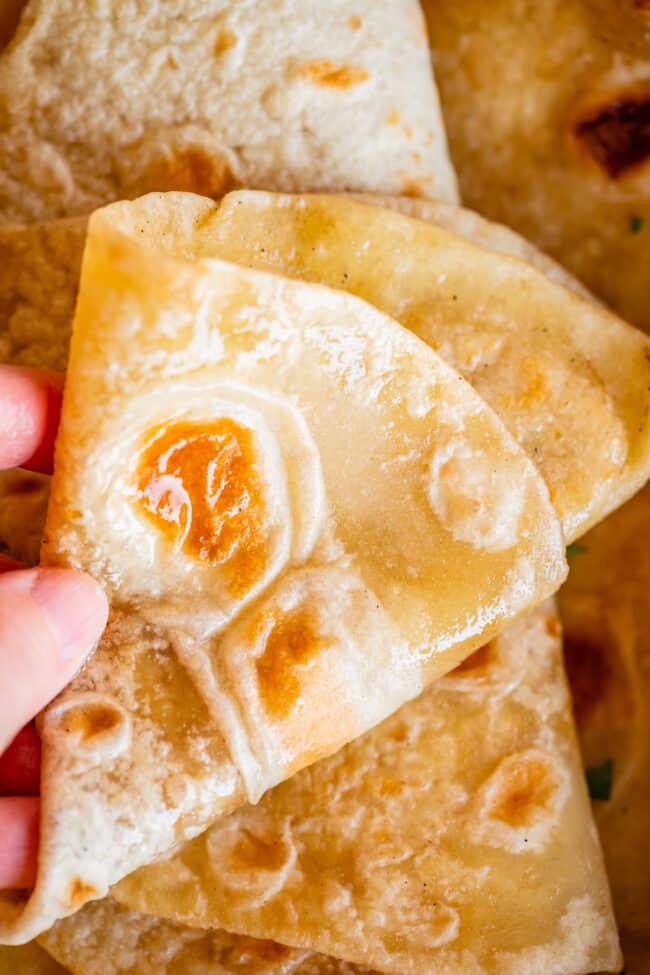
I feel like this is the opposite of most people?? I’m pretty sure if someone offered me a free pizza I wouldn’t have to be reminded that I have a free pizza on the line. I mean right? More like, “I’m definitely not eating anything else or even opening my fridge until I have hot pizza in my mouth.” Or maybe this is just me and my scavenging ways. Free food or bust, man.
You know what I can’t get for free? Roti bread. Have you tried this stuff? I’M OBSESSED. I can’t even find it on the menu in most Indian restaurants where I live in California (all hail the Naan, apparently, sheesh talk about a diva.)
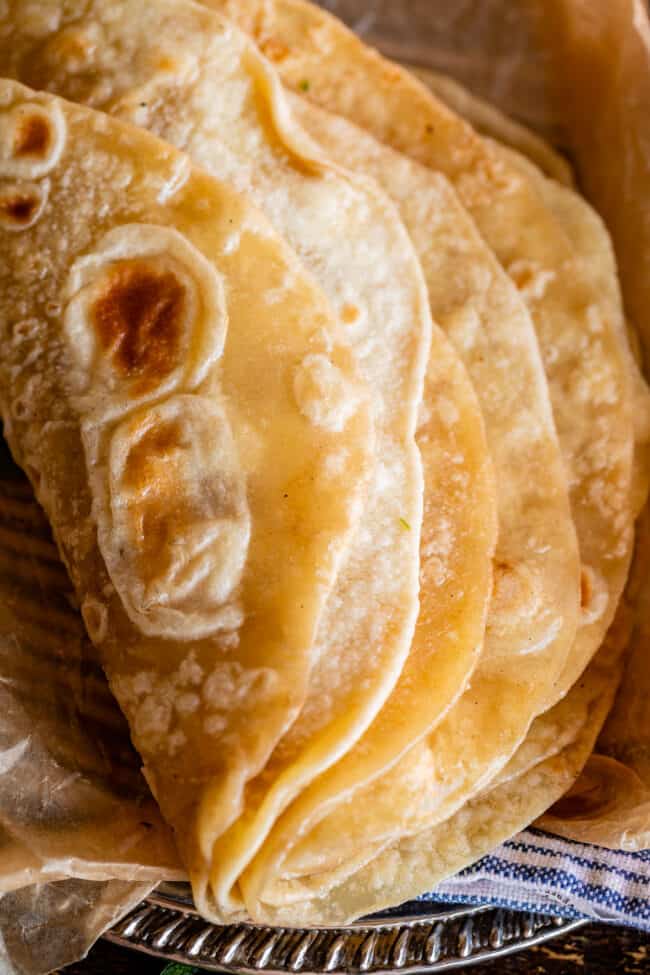
I love me some Homemade Naan but I feel like the world needs to know about Naan’s skinny kid brother Roti, who could totally take Naan down in an arm wrestling match, I’m just saying. He’s might be skinny but he’s smooth. He might not have that yeasty Naan puff but he’s soft and pliable for days. Okay this analogy is going downhill fast, let’s get into the details:
What is Roti?
Roti is an Indian flatbread traditionally eaten alongside curry or other saucy Indian dishes.
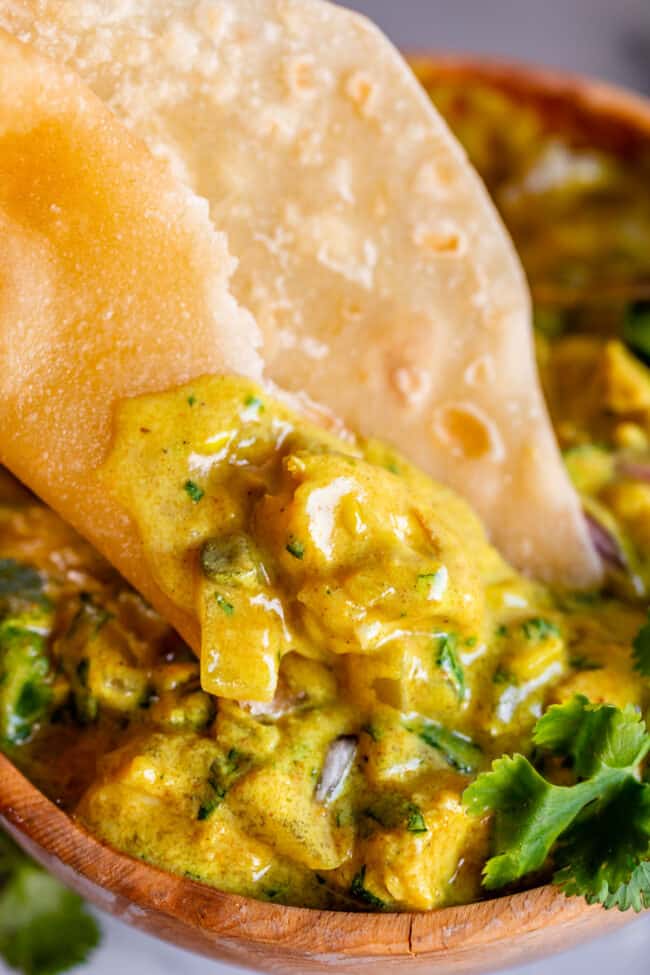
Roti is unleavened, meaning it doesn’t have any yeast or baking powder to give it that springy texture. It is traditionally made with just two ingredients, Indian whole wheat flour (“atta”) and water. When made correctly, it is soft and buttery and chewy and tender, similar to a Mexican tortilla.
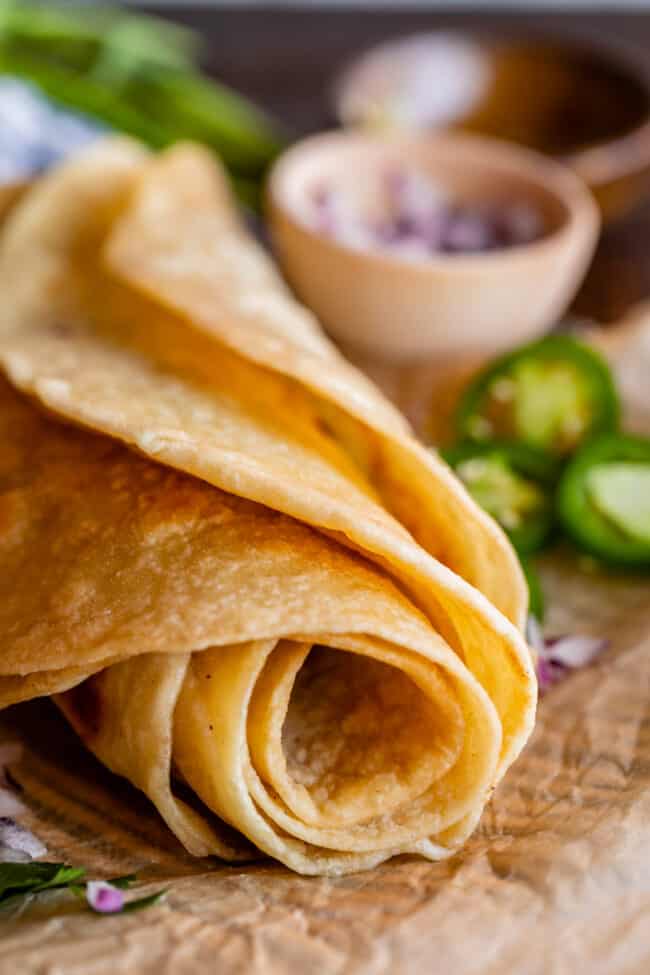
Roti also is sometimes called Chapati. Roti is traditionally made with just flour and water, some define chapati as a version with flour, water, salt and oil (or butter, as in today’s recipe). Some regions or families might roll theirs out to different thickness levels. There’s always more than one way to make a classic recipe like Roti! But the result is always a soft, pliable, deliciously flavorful vehicle to get even more saucy curry into your mouth. Yum.
Is Roti the same as Naan?
No it’s not the same, although they are usually eaten in the same way: alongside curry. Naan is another type of Indian bread, but it is made with dairy (like butter, sour cream, or yogurt) and has yeast in it. It rises a couple times before you roll it out and fry it, just like roti.
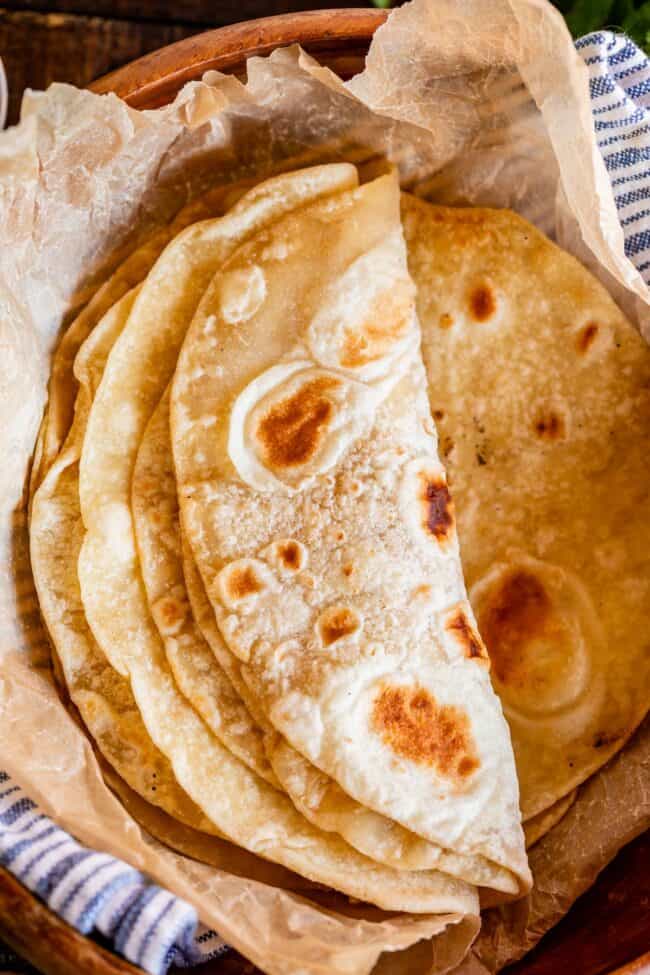
It’s really hard to choose between roti and naan, let me just say. They are both SO good!
My brother was over this week and was enjoying some of my test Roti’s, and was going on about how he likes it so much more than Naan. He lived in India for a summer, so has a lot more first hand experience with legit Roti than I do. I don’t pick favorites, give me Roti or give me Naan and I will be double time excited about my curry!
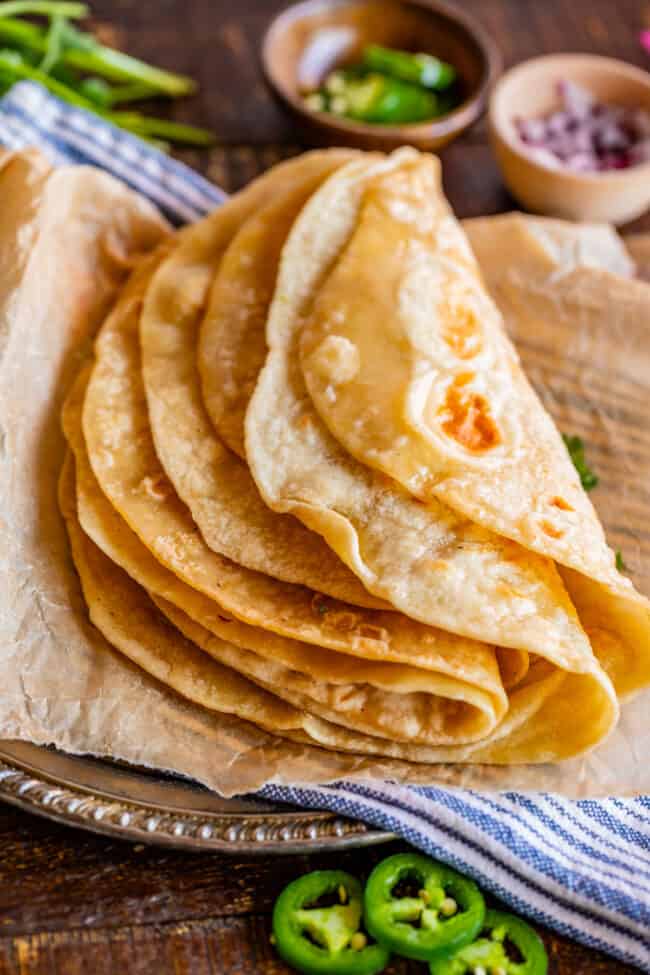
Roti Recipe Ingredients
Here’s everything you need!
- Bread flour. You can substitute all-purpose flour in a pinch, but your roti won’t be as chewy. More about flour choices below!
- Salt. I like to use kosher salt, but table salt is fine too.
- Butter. I use salted butter. Vegan variation: use oil!
- Water. I like to use warm water to make the dough nice and pliable.
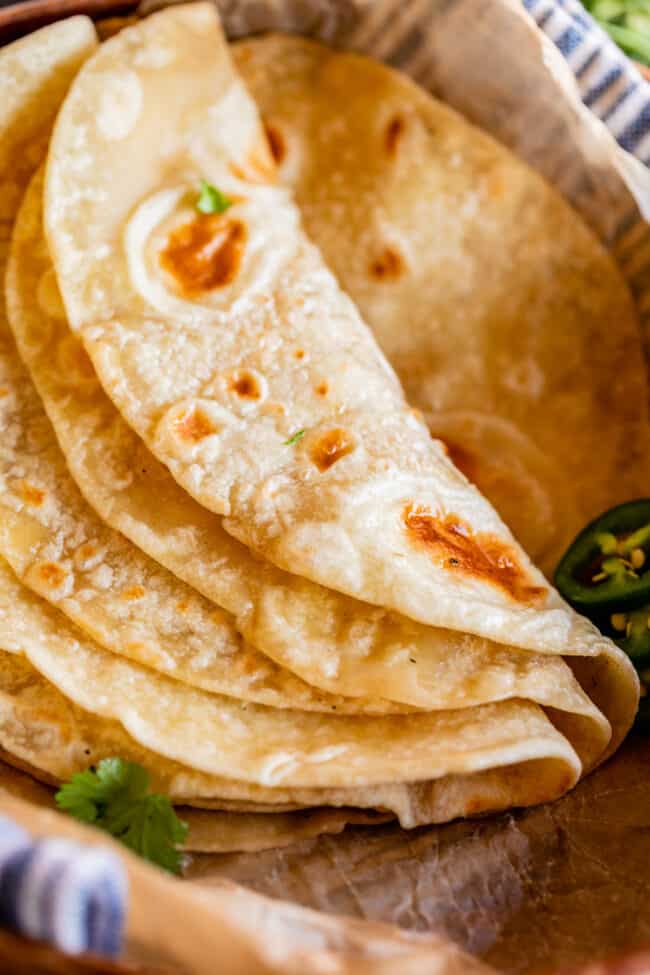
How to make Roti (Indian Bread)
I’m telling you guys, it could not be any easier to make this dough. You can basically do it in your sleep. Here is a quick overview. I’ll go over all the method details below, and of course the recipe card is at the bottom of the post.
- Mix together flour and salt
- Add butter and cut it in to make crumbles
- Add water to form dough
- Knead
- Rest
- Roll
- Fry
- Steam
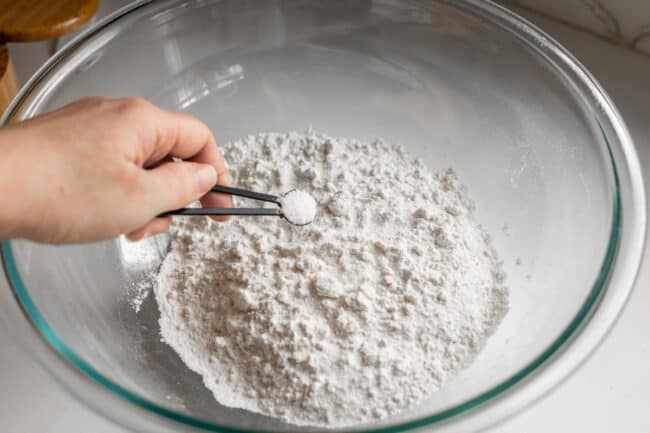
Add some salt to your bread flour and whisk it together. Traditional roti is unsalted, but I’m sorry, I just can’t. Bread is just not worth the calories if there is no salt in it, haha. All the Florentines in Italy are coming for my head too. (Florentines are famous for not salting their bread.)
Before we move on, a note about the flour you use:
Which flour is best for Roti?
Traditional Roti bread made in India is made with just two ingredients, Atta flour and water. Atta is a type of Indian whole wheat flour. It has a high protein content, which makes your dough nice and strong, meaning it won’t fall apart when you roll it out super thin, as is necessary for Roti.
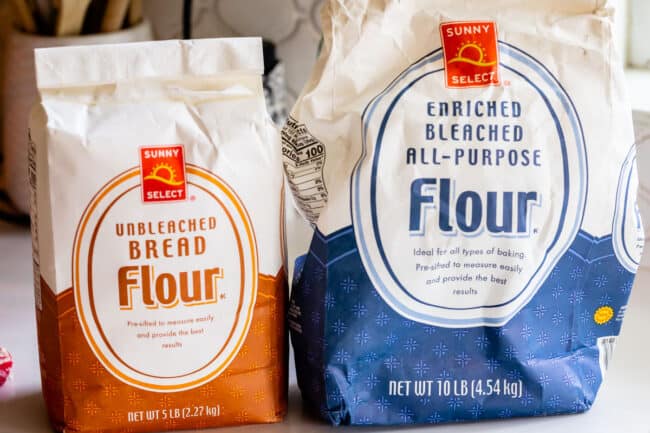
Since Atta is not a common ingredient where I live, I substitute bread flour. Bread flour has a high protein content just like Atta, and is much more pliable than the whole wheat flour options we have available around here. (If you use whole wheat flour, your roti will be very difficult to roll out, and will be tough instead of chewy.)
You can also use all-purpose flour. Since all-purpose doesn’t have as high protein content, your bread will be a little less chewy, but it will still be good.

After whisking your flour and salt together, pour in about 2 tablespoons butter and cut it in with a fork. This makes your bread extra tender and adds great flavor! Oil or ghee will work fine too.

Next add some warm water. Use the same fork to stir it all together until a dough forms.
Knead for about 8 minutes. You can do it by hand or use a stand mixer. As you knead, all that protein in your flour is going to combine to form strands of gluten, making your dough nice and strong and able to be rolled out.

Let the dough rest covered for about 20-45 minutes. It is not rising, as with yeast dough. Your dough is going to look exactly the same at the end of the rest time, and you are going to curse my name and hate me for wasting your time 😉
But trust me! The rest time allows the gluten in your flour to relax after all that kneading, making your dough much easier to roll out. If you try rolling out your dough and it just keeps springing back to the same shape, rest it a while longer. The longer it rests, the easier it will be to roll out.

Divide the dough into 6 pieces, and use your fingers to pinch them into smooth round balls.
Take one piece and flatten it out into a disk with your fingers. Use a rolling pin to roll the dough out into a circle.
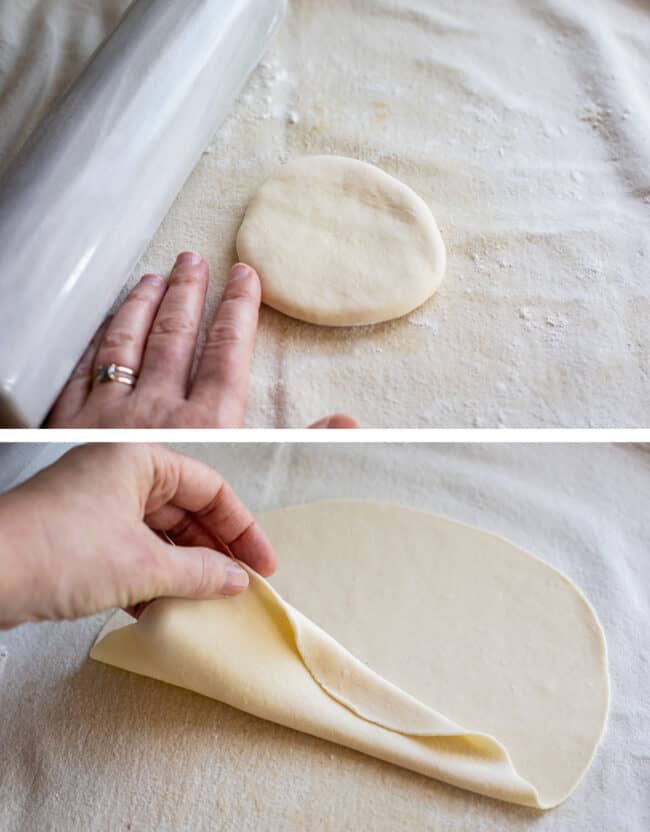
See how thin it is? If you don’t roll it out thin, your bread won’t be as tender. I like to roll to about 8-9 inches. It’s okay if it’s not a perfect circle! Embrace it!
Next, heat a skillet over medium or medium high heat. You will have to figure out what heat level is best on your own stove, to make it cook fast without burning. I like to use my cast iron skillet.

When the pan is nice and hot, add about a teaspoon of butter to the pan and swirl it around. Carefully transfer your rolled out roti to the hot pan and then count for about 6-7 seconds.
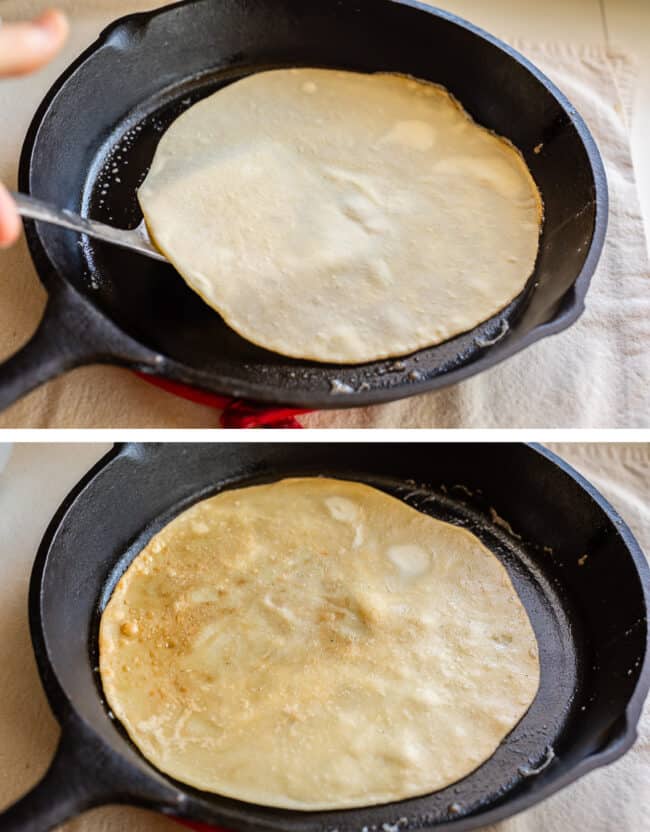
After a few seconds, carefully flip the roti with your fingers or a spatula. Add more butter if necessary. The bottom side is not cooked yet, we just wanted to coat it with butter so that it doesn’t dry out.
Cook the roti for about 30-50 seconds. You will know it’s ready to flip when bubbles have formed on top, and the underside is browning.
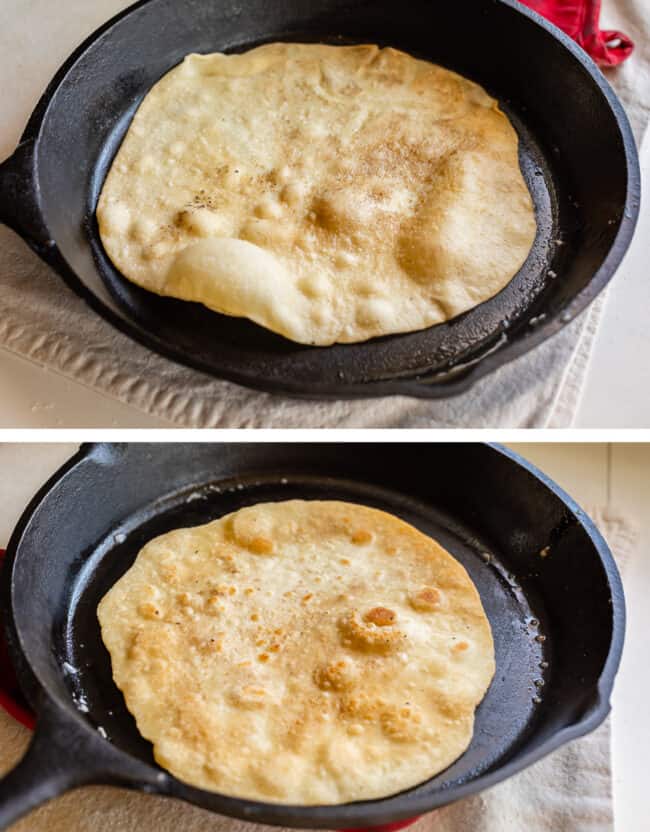
Flip the roti, adding more butter if necessary, and cook the second side just until brown spots appear, another 20-40 seconds. Now for the most important step: steaming.
Best way to store this Indian Bread
We’re not done yet! If you have plans to eat this roti within 30 seconds of it coming off the pan, perhaps over the kitchen sink with a rabid gleam in your eye, then feast away.
However, if you are planning to serve this at dinner like a civilized human, there is going to be some wait time between coming off the pan and eating. If you leave your roti sitting out, it will get tough as it cools and even (gasp!!) start to get crackly. No, no!!
Steaming is the answer, just like is done for tortillas. If you have a tortilla warmer, use it! I don’t have one, so I use a ziplock bag as a makeshift steamer.
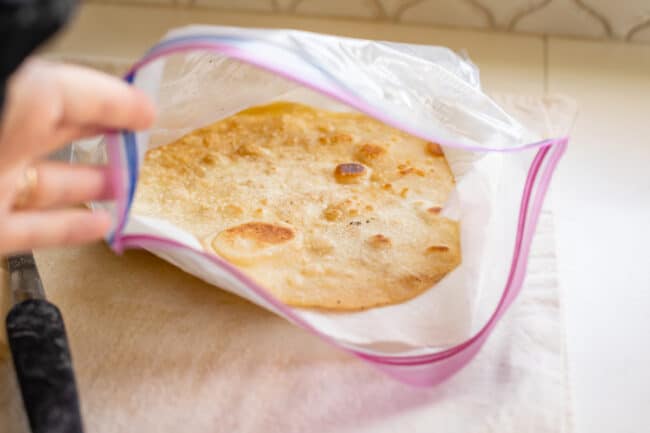
Place a paper towel in a large ziplock. Add your hot-off-the-pan roti on top of the paper towel. Top with another paper towel and quickly zip up the bag. When you add a second roti, place it directly on top of the first one, with no paper towels in between. They will steam each other and get all cozy and soft.
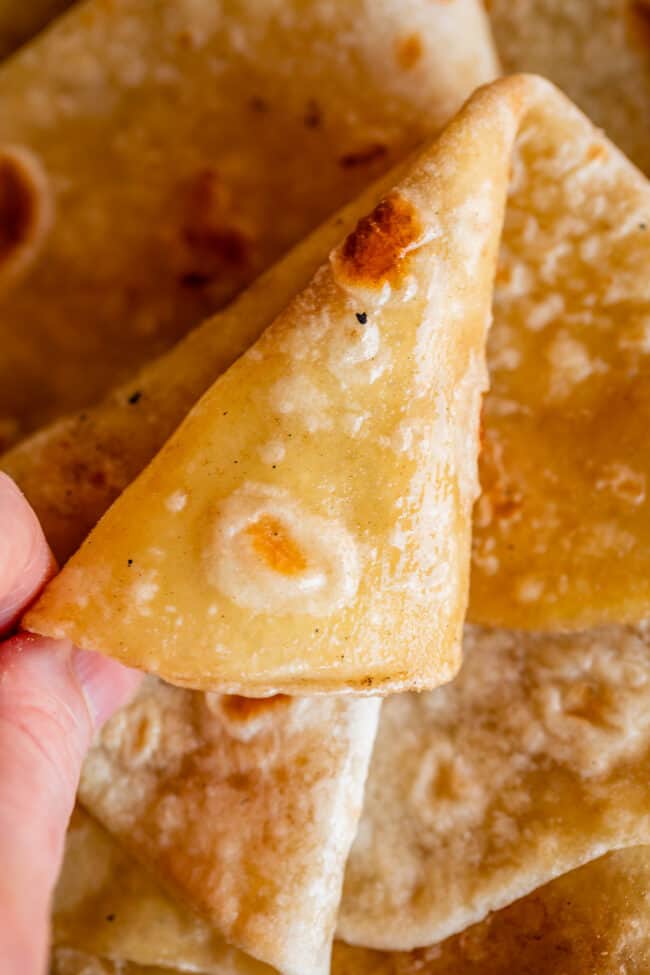
Steaming your roti is an essential step to keeping your roti soft and pliable, do not skip it!
If you have leftover roti, store in that same paper towel-lined ziplock bag. There is no need to refrigerate. Store it at room temperature for 1-3 days.
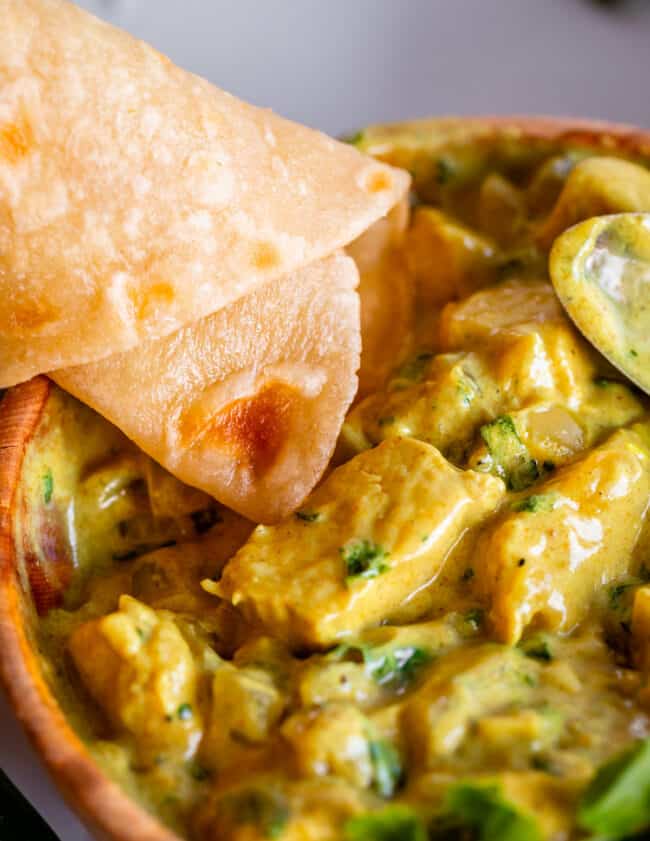
Can you make roti vegan?
Yes totally! It’s actually really easy to do! Just replace the 2 tablespoons butter called for in the recipe with oil. Then do your pan frying in oil too. Easy peasy!
For frying, use an oil that has a high smoke point so that you don’t set off your smoke alarm. Canola oil, vegetable oil, or LIGHT olive oil will all work fine. (Light olive oil means it has a light olive taste, unlike extra virgin. Wouldn’t it be nice if it meant light in calories? It’s definitely not, haha.)
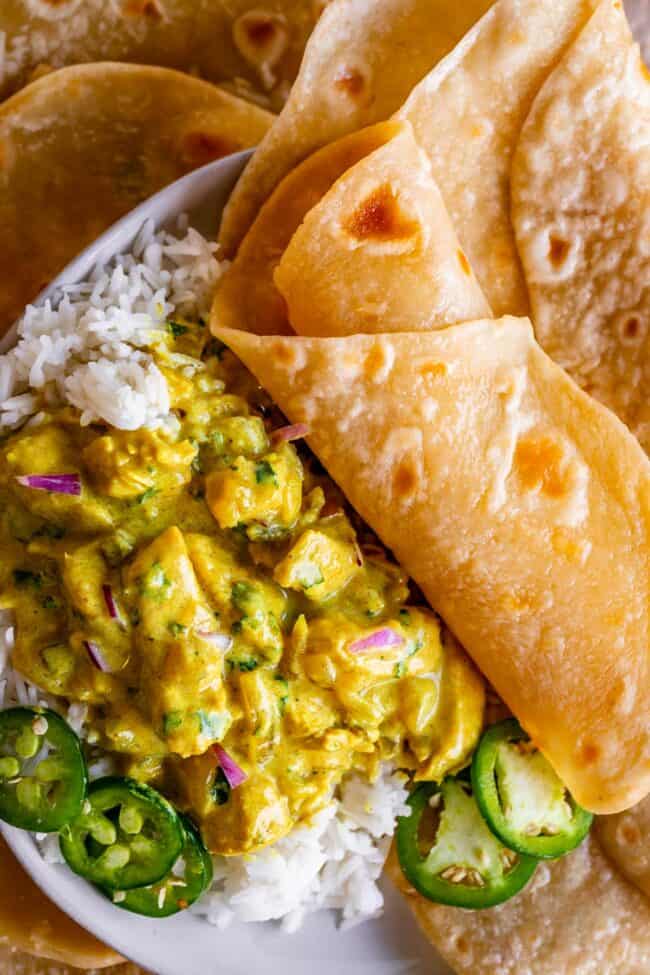
Does Roti freeze well?
Yes! Freezing preserves the moisture and keeps the roti softer than fridge storage, so if you want to keep it longer than a day, I would toss it in the freezer. Layer your roti between sheets of parchment paper so they don’t stick to each other, and seal in a ziplock bag. Store flat.
To reheat, you can either let thaw in the bag at room temperature, then reheat gently in the microwave (don’t overdo it or they will get tough.) Or you can re-grill the roti straight from frozen, using the same method as the first time.

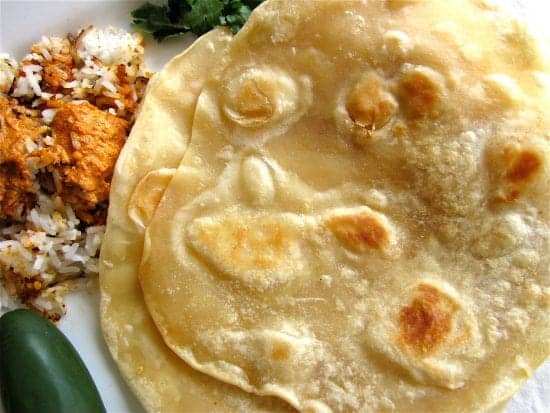 Here is my original picture from way back in 2012 when I first made this recipe!
Here is my original picture from way back in 2012 when I first made this recipe!
What do you serve Indian Flatbread with?
Roti is the BEST tool for cleaning up a plate of Indian food, whether it’s the Easy Chicken Curry you see in today’s photos (recipe coming next week!), or this Slow Cooker Chicken Tikka Masala. Basically anything saucy that begs for a bread-ish tool to clean the plate. We’re not leaving any of this curry on the table, not on our watch. No sauce left behind. SOS, Save Our Sauce. Roti to the rescue! Try out these other curries:
More bread recipes you are going to love!
Facebook | Pinterest | Instagram
 Print Recipe
Print Recipe
from
votes
Roti Recipe (Buttery Indian Flatbread)
I can’t get enough of this Roti recipe! Roti is a super easy and delicious Indian flatbread. It is amazing when served with curry, totally perfect for sopping up extra sauce! I have all the tips you need to make sure this Indian bread turns out super soft! I will show you just how to make roti, step by step!
Ingredients
-
▢
2
cups
bread flour
,
or all-purpose flour, spooned and leveled
-
▢
1
teaspoon
salt
-
▢
2
tablespoons
butter*
,
melted
-
▢
2/3
cup
warm water
-
▢
1/4
cup
butter
,
for frying, or more as necessary
Instructions
-
Make the dough. In a large bowl or stand mixer, use a fork to whisk together 2 cups bread flour and 1 teaspoon salt. (I prefer kosher salt, but table salt is fine.)
-
Add 2 tablespoons melted butter* and mix it in with the fork until the flour is crumbly. Make sure to break up any big chunks.
-
Add 2/3 cup warm water. Mix it together with the fork until the dough pulls together. At this point, I start using the dough hook attachment on my stand mixer, but you can also turn the dough out onto a lightly floured surface.
Knead until smooth and elastic, about 8 minutes. Scrape down any dough that sticks to the side, but it should form itself into a ball pretty quickly.
-
Rest the dough. When you are done kneading, shape it into a ball. Leave it in the bowl, cover with a tea towel, and let rest for 20-45 minutes. The longer you rest the dough, the softer and more pliable your roti will be, and the easier it will be to roll out. (It will not rise at all, so don’t expect it to look different after the rest period. This ain’t no yeast recipe.)
-
Roll out the dough. Prepare a work surface with a light dusting of flour. Divide dough into six equal parts. Use your fingers to pinch each piece into a smooth ball. (see photos)
Take one ball and pat it into a disk with your fingers. Use a rolling pin to roll the dough into a rough circle about 8-9 inches across. It should be rolled out very thin, see photos.
(If you want to roll all the dough out at once before frying, stack the sheets, each one separated with a square of parchment paper so they don’t stick together. I prefer to roll out my next piece of dough while I’m frying the first one, so I don’t do this.)
- Cook the Roti. Set
Set a cast iron skillet , griddle, or large frying pan over medium or medium high heat. Let it preheat for at least a couple minutes so that it’s very hot.
Add about a teaspoon of butter to the pan and swirl to coat the bottom.
-
Transfer the very thin sheet of roti dough to the pan. Wait about 6 or 7 seconds, then use your fingers or a spatula to flip the roti over. You may need to add more butter; if there is not enough, the roti will not be soft. It will cook in 30 to 50 seconds. Adjust the heat as necessary so that the roti cooks quickly (under a minute) but does not burn. Every stove is different so you will have to play around.
You will know it is done when light brown spots appear on the side that is cooking. The top should have a few bubbles. Flip the roti back to the original side (using more butter if necessary) just until the brown spots appear, another 20-30 seconds.
-
Steam the Roti. This step is super important to get soft and pliable roti! Place a paper towel inside a large ziplock bag. When the roti is done frying, place roti on top of the paper towel in the bag. Top the roti with another paper towel (it should not be touching the plastic or it will get soggy.) Seal the bag.
As you fry the remaining roti, add them to the ziplock directly on top of the first roti, with a paper towel on top. The roti will steam each other in the center. Keep the bag closed as much as possible. You can also skip these steps and steam roti in a tortilla warmer
-
Serve the roti hot, with curry and rice
-
Store leftover roti in a ziplock bag lined with paper towels.
-
Freezing Roti: Layer your roti between sheets of parchment paper so they don’t stick to each other, and seal in a ziplock bag. Store flat in the freezer.
To reheat, you can either let thaw in the bag at room temperature, then reheat gently in the microwave (don’t overdo it or they will get tough.) Or you can re-grill the roti straight from frozen, using the same method as the first time.
Notes
*You can make this vegan by using oil in the dough, and frying in oil. Ghee is a good substitute as well! (not vegan!)
Nutrition
Serving:
1
roti
,
Calories:
252
kcal
,
Carbohydrates:
30
g
,
Protein:
5
g
,
Fat:
12
g
,
Saturated Fat:
7
g
,
Polyunsaturated Fat:
1
g
,
Monounsaturated Fat:
3
g
,
Trans Fat:
1
g
,
Cholesterol:
30
mg
,
Sodium:
491
mg
,
Potassium:
45
mg
,
Fiber:
1
g
,
Sugar:
1
g
,
Vitamin A:
354
IU
,
Calcium:
11
mg
,
Iron:
1
mg
Calories:
252
kcal
Tried this Recipe? Tag me Today!
Mention @TheFoodCharlatan or tag #thefoodcharlatan

